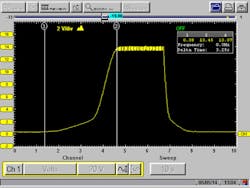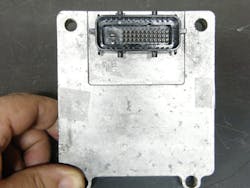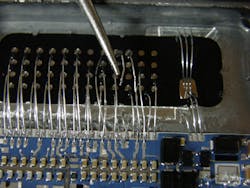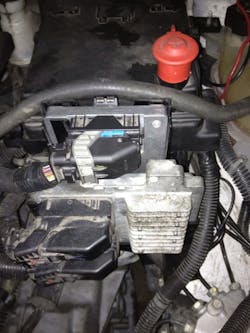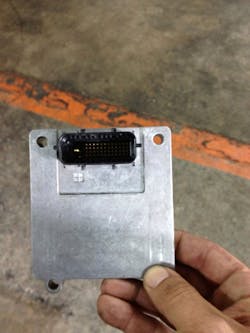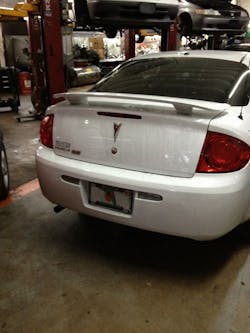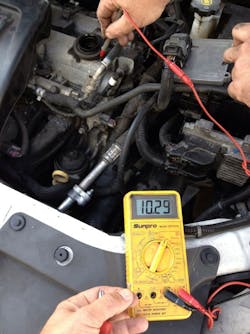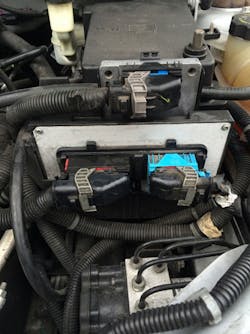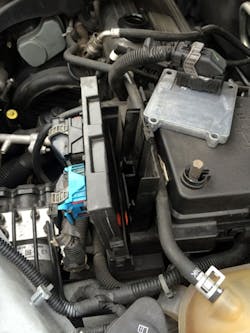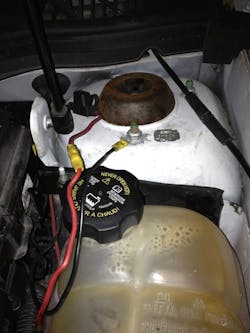There are times in the diagnostic process when it comes down to deciding whether the malfunction is caused by the computer or not. It’s not so bad to take a chance with the computer if it costs $150 or less dollars. But it’s a big decision when you are looking at $1,200! Similarly, when it comes to older vehicles, the price of a computer might not be too high but is the job costing more than the vehicle is worth.
Recently, Bill Harris from Deltrans in Newark, Del., had to make a choice between pulling the transmission or changing the computer. He was dealing with a 2000 Chevy Blazer 4.3L V6 engine with a 4L60-E transmission in it that was rebuilt by his shop less than 3,500 miles ago.
The vehicle arrived at the shop with a customer complaint of a late 2-3 shift and slipping through the other shifts during light to medium throttle conditions. The fluid was checked and found to be clean and full. A code P0758 for a 2-3 shift solenoid circuit error was pulled out of the VCM. They documented the code and then cleared it. The code did not return for the duration of his diagnosis.
“Driving the vehicle,” he said, “felt like a late 2-3 shift and if it was accelerated quickly, it seemed as if it was skipping third and then flared into 4th. Honestly I thought, this transmission had burnt the 3-4 clutches.”
Instead of pulling the unit right away, Bill decided to put a DVOM on the 2-3 solenoid circuit to verify its integrity since there was a code for it originally. He was able to confirm that there were no shorts to ground or power and the solenoid resistance was within spec. At this point he had asked himself, “Now where do I go?”
He took a gamble and monitored the operation of the 2-3 shift solenoid which the VCM controls on the ground side. Bill felt the power wire was good because it is supplied to all the other solenoids and they were functioning fine. After back probing into the circuit with his Fluke meter, he was not surprised to see several tenths of a volt when the solenoid was commanded on. But what did catch his attention was when the solenoid was commanded off. It showed a very slow climb to battery voltage and about the time the voltage got to 12 (fully off), the truck would make the shift.
After seeing this he was able to determine that the 2-3 shift solenoid could not turn off fast enough to make the 2-3 shift. The 1-2 solenoid is off in second gear while the 2-3 solenoid is on. All the computer needs to do to make a shift into third is turn the 2-3 solenoid off. Since the VCM was not releasing the ground fast enough the transmission remained in second gear. As speed increased, the 1-2 shift solenoid turns on to make a 3-4 shift. The 2-3 shift solenoid should remain off. With a slow release of the ground, the 2-3 shift solenoid remained energized. This means the transmission actually shifted into first gear. The speed in which this took place was to fast for first gear to be engaged as the low roller clutch is freewheeling causing the transmission to neutralize.
From seeing this, Bill decided to replace the VCM ($225.00 ACDelco new) which was spot on. The vehicle drove perfectly and there was no need to pull the transmission.
The graph in Figure 0 was captured by Bill on a Modis during an attempted 2-3 shift for this article. The area between the markers 1 and 2 show the slow release of the ground as the solenoid was being turned off. It should have had a much sharper vertical rise similar to how quickly the vertical drop was it was energized shortly afterwards.
Part Two of This Story
At the end of the 4L60-Evolution article in June of 2013, code P0717 for a no or low Input Speed Sensor (ISS) signal was mentioned due to a defective TCM (Figure 1). The internal ground connection for the ISS from the TCM’s harness connector to the circuit board had severed (Figure 2). Not too long ago, Ralph at Alonso’s Transmissions sent me some pictures with an explanation of a different type of concern he has dealt with on several occasions. It has to do with the same style TCM (Figures 3 and 4) which is used in either a Chevrolet Cobalt or a Pontiac G5 (Figure 5). Both style vehicles are equipped with the 4T40/5-E transmission.
FIGURES 1-4
The car comes to the shop in failsafe 2nd gear. When a scan tool is used to pull codes there is no communication to the TCM (Figure 6). When checking the TCM for power and grounds, they discovered an unusual problem. The tech decided to do a voltage drop test from the TCM casing to ground and saw 10.29 volts (Figure 7). There are no indications from any wiring that a ground is provided for the TCM from the casing through its mounting bolts. Beside not ever seeing any computer grounded in such a manner, this TCM is mounted in a plastic sleeve and is not bolted to anything metal (Figures 8 and 9 were taken from a Cobalt). So to see 10.29 volts from the TCM casing to ground seems to indicate a lifted ground.
For this TCM, there is one ground wire from terminal 49 which goes to a stud that screws into the transmission called the G105 ground. If this ground was lifted, it could be the explanation of why such high voltage is seen when doing a case to ground voltage drop test.
FIGURES 5-8
The next step taken by the tech was to run a ground from the casing to the shock tower to see what would happen (Figures 10 and 11). Once the ground was run, the scan tool was able to communicate and the transmission shifted fine. A new TCM was installed and down the road it went.
I have wanted to get my hands on one of these TCM’s so I can see what is really going on but the defective TCM is given to the dealer to prevent a core charge. I can only assume the internal ground circuit breaks in a similar manner as the ground for the ISS with the 4L60-E.
FIGURES 9-11
But what I do know is that whenever a Chevy Cobalt or a Pontiac G5 comes into the shop Ralph has his tech perform a voltage drop test on the TCM casing to ground. If voltage is observed he runs a temporary ground. If communication problems are resolved and the transmission begins shifting, it’s a confirmation the TCM is faulty and needs replacement. But I would like to add, should the G105 ground develop problems for any reason, it may result in a similar symptom. A good idea would be to check the actual ground path first before condemning the computer. And for 150 bucks, it’s a good idea to buy a new one if needed and not leave the “make shift” ground on the shock tower.
